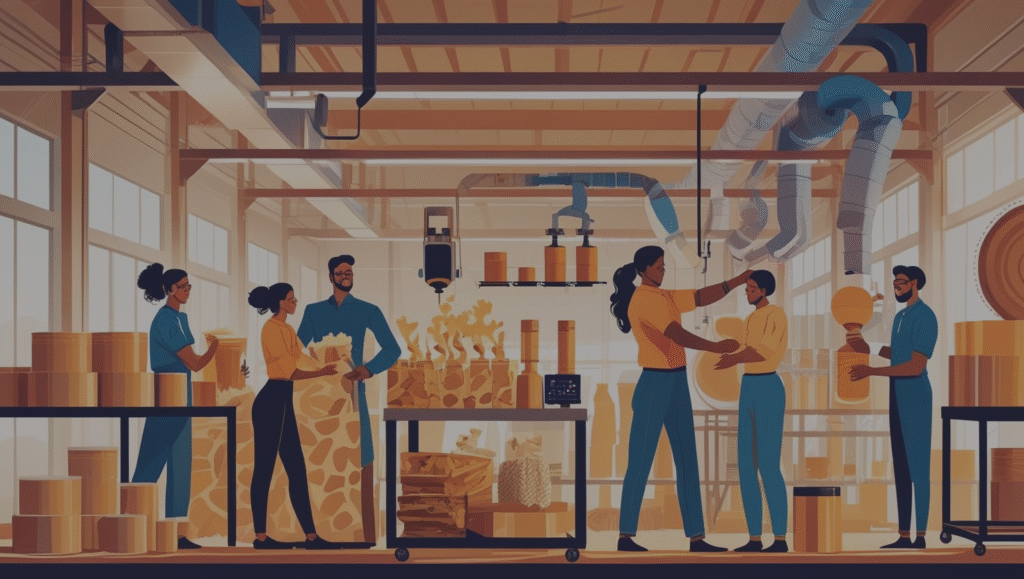
With the Indian packaging market expected to reach USD 204.81 billion by 2027, at a 26.7% CAGR, the transition towards bio-based adhesives is picking up steam, fueled by regulatory pressures and consumer demand for environmentally friendly solutions.
Plant-based adhesives, from renewable resources such as starch, soy, and cellulose, are revolutionizing fast-moving consumer goods (FMCG) and logistics packaging with green alternatives to petrochemical-based glues.
While environmental issues redefine the industry, Indian producers are reinventing to compete at international standards, albeit with high prices and performance issues likely to hinder mass uptake.
The packaging sector, the backbone of India’s USD 1.5 trillion retail industry, is under growing pressure regarding its ecological impact. Control systems, such as the Bureau of Indian Standards (BIS) and the Plastic Waste Management Rules, 2016, require lower volatile organic compound (VOC) emissions and recyclability.
Worldwide, legislation such as the EU’s REACH is limiting dangerous substances like formaldehyde in adhesives, driving exports, which are 15% of India’s packaging adhesives, toward alignment.
Consumer tastes are changing as well, with 65% of city-dwelling Indians opting for sustainable packaging, according to a 2024 Nielsen survey, boosting demand for bio-based alternatives in FMCG and logistics.
Bioadhesives, derived from plant resources, have substantial environmental advantages such as biodegradability, low toxicity, and lower carbon footprints.
Starch adhesives, derived from corn and potato wastes, hold sway over the corrugated box industry, a market that is expanding at 8% per annum.
These adhesives, utilized by firms such as UFlex, produce bonding strengths of 4-5 MPa, appropriate for light packaging, and reduce VOC emissions by 80%, according to a 2024 FICCI report. Soy adhesives, with their increasing adoption in FMCG labeling, offer water-resistant adhesion when cross-linked with cross-linking agents, beneficial for use in the packaging of beverages and foods.
Soy adhesives from Pidilite Industries, applied in paperboard cartons, have lowered production emissions by 25% since 2023.
Cellulose adhesives, from wood pulp, are increasingly being used as a flexible packaging material with varied applications. High-tensile nanocellulose improves adhesive performance, to 6 MPa in laminated films, according to a 2023 IIT Bombay report. E-commerce packaging is being developed with cellulose-reinforced adhesives by startups such as Specialty Organics, in line with the industry’s 20% growth per annum.
Lignin adhesives, derived from India’s 20 million-ton pulp production, provide biodegradable bonding for secondary packaging at 70% of phenol-formaldehyde’s strength, according to a 2024 study, making them particularly suitable for logistics use.

Innovations are filling performance gaps. Glyoxal and tannic acid cross-linking suppresses formaldehyde emission in starch and soy adhesives, adhering to REACH’s no-added-formaldehyde (NAF) requirements.
Castor oil-based vegetable oil adhesives offer thermal stability for high-speed packaging lines, with FMCG applications growing 10% every year.
At the last industry fair, BASF exhibited bio-based hot-melt adhesives with 50% renewable content that match petrochemical counterparts in adhesion while lowering energy consumption by 15%. These products align with India’s National Green Mission, which focuses on sustainable material use in packaging.
Government support is driving adoption. The Production-Linked Incentive (PLI) program encourages R&D in green adhesives, with Rs. 50,000 crore to be contributed to the National Research Foundation (NRF) for collaborative industry-academia research.
The Raising and Accelerating MSME Performance (RAMP) program supports smaller companies, which manufacture 40% of packaging adhesives, to shift to bio-based technologies. The Extended Producer Responsibility (EPR) system under the Plastic Waste Management Rules promotes recyclable packaging, leading to a demand for biodegradable adhesives.
The Skill India Digital Hub has educated 2 million workers in next-generation manufacturing, including bio-adhesive use, since 2023.
Despite improvement, challenges remain. Bio-based adhesives are 20-30% more expensive than petrochemical alternatives, which can be a strain on MSMEs, with only 15% using these formulations, according to a 2024 SIDBI report.
Performance constraints, such as reduced water resistance in starch adhesives, limit application in humid environments, an issue in India’s monsoon-season areas. Shortages of skills, where only 5% of the population is trained in bio-based adhesive technologies, according to Nasscom, stifle innovation. Infrastructural challenges, such as unreliable power supply in Tier 2 towns, cause production halt, amounting to Rs. 1-2 lakh per month for SMEs, according to industry debate.
Low awareness among rural markets, where the cost factor outweighs sustainability, delays adoption.
To surmount these challenges, the experts suggest strategic interventions. Subsidies through Technology Upgradation Scheme can absorb costs for MSMEs. Scaling up Skill India training in bio-based technologies will help fill skill gaps. Enhanced 5G connectivity and power availability, as envisioned under PM Gati Shakti, will aid production.
Public-private initiatives, as with IITs, can scale R&D for low-cost formulations. CII awareness campaigns can spur demand for smaller markets, leading to increased MSME adoption.
India’s packaging sector is adopting bio-based adhesives as a way of addressing regulatory and consumer needs, setting itself up for a leadership position in sustainable solutions.
With a USD 3 billion adhesive market predicted by 2030, development in plant-based formulations is essential to maintaining performance while being environmentally friendly.
By breaking through cost, skill, and infrastructure challenges, Indian manufacturers can take advantage of the FMCG and logistics boom, making a greener, more sustainable future for packaging.
